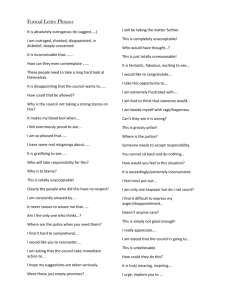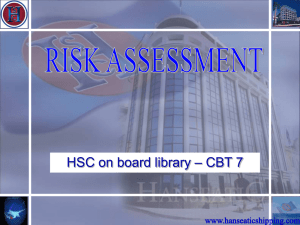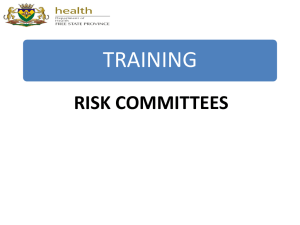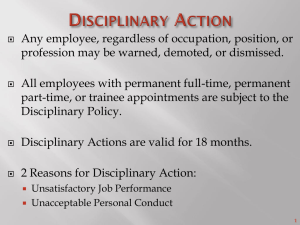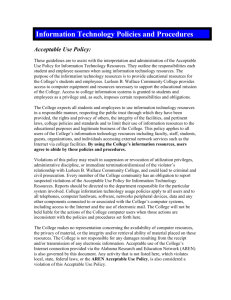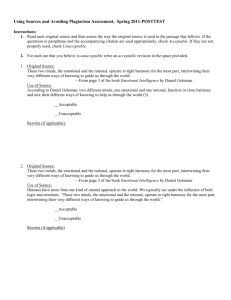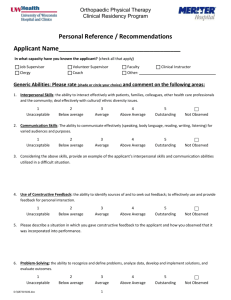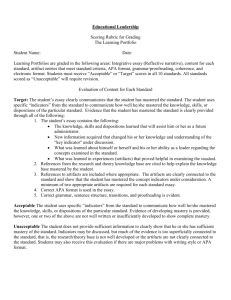EHEST SMS Safety Database User Guide
advertisement
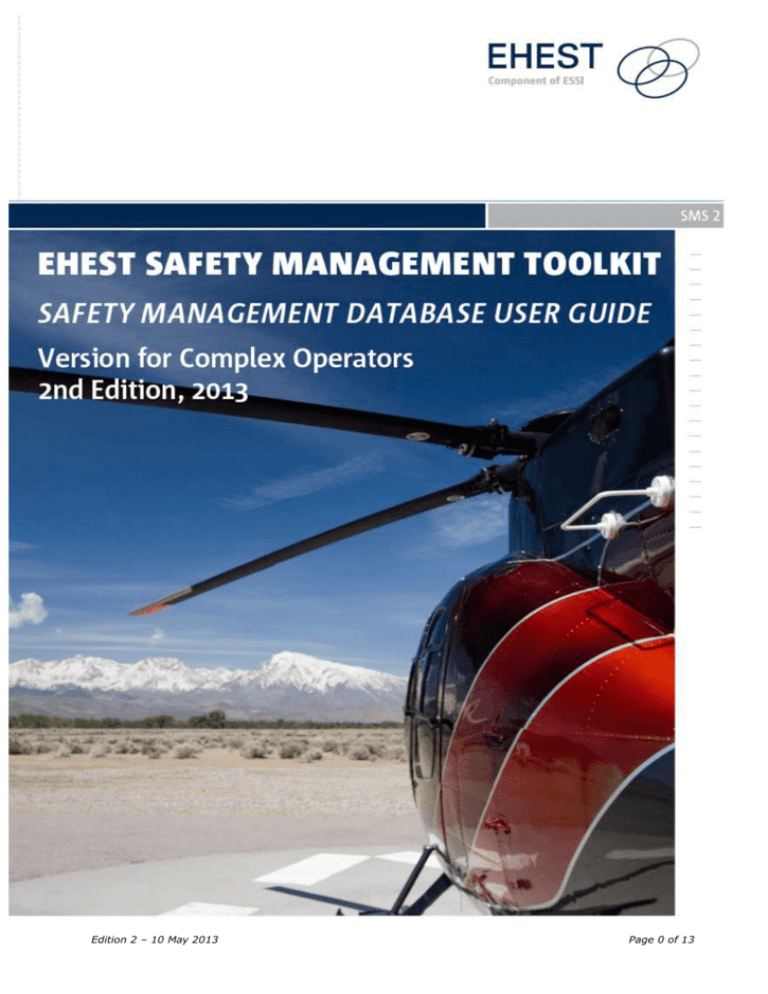
Safety Database User Guide Edition 2 – 10 May 2013 Page 0 of 13 Safety Database User Guide European Helicopter Safety Team Safety Management Database User Guide Edition 2 10 May 2013 Edition 2 – 10 May 2013 Page 1 of 13 Safety Database User Guide Contents 1. Risk Management and the Use of Safety Databases ........................................ 2 2. Occurrences Database .................................................................................... 4 3. The Hazard Identification File ......................................................................... 4 4. Undesirable Events File .................................................................................. 7 4.1 Sample "Commercial Air Transport " UE Sheet ............................... 7 4.2 "Risk Matrix" Sheet......................................................................... 9 4.3 "UE xx" Sheets ............................................................................... 9 5. Risk Analysis Monitoring Sheet ..................................................................... 11 1. Risk Management and the Use of Safety Databases The EHEST Safety Management Toolkit provides example registers of some of the typical helicopter hazards and risks developed by Eurocopter for Commercial Air Transport (CAT) operations. These registers of hazards and risks are a unique feature made available by the EHEST to the helicopter community for safety management purposes. It must however be taken into account that risks will differ depending on the operator, nature of operations and any existing barriers in place. So, the registers provided by the EHEST are just examples that need to be tailored by the operator. Risk management is a continuous improvement process, in other words it must be subject to constant evaluation and updating. Tools have been produced by the Specialist Team Operations & SMS of the European Helicopter Safety Team (EHEST), which are designed to assist in establishing an effective SMS and risk management process by setting out examples of the types of database that can be used. It should be reiterated that helicopter operations involve exposure to hazards. These hazards, if not controlled or mitigated, can develop into the occurrence of Undesirable Events (UEs), which may ultimately lead to a loss of control on the situation. In such a situation the operator must then apply an appropriate control/mitigation strategy to prevent UEs from developing into an accident. In the context of a Safety Management System (SMS), the operator must compile and maintain a database of the hazards relevant to their scope of operations. A risk analysis must be conducted for each of the Undesirable Events. This analysis may or may not lead to the implementation of risk control/mitigation measures, depending on the level of acceptability of the risk identified. The EHEST SMS approach considers the creation of at least the following three types of safety database: 1. A database listing the hazards to which an organisation is exposed. 2. A database of undesirable events and corresponding hazards. 3. A database of all other events/activities which may include exposure to risk. Edition 2 – 10 May 2013 Page 2 of 13 Safety Database User Guide Examples are provided for each of these three types of database as follows: 1. The "Hazard Identification.xls" Excel file for the database of hazards. 2. The "Undesirable Events.xls" Excel file for the database of undesirable events. 3. The "Risk Analysis.xls" Excel file for the database of other risks. A fully functional SMS will involve listing each incident such that lessons can be learned from their analysis. To that end an example of an "Occurrences Database.xls" file is provided. The diagram in Figure 1 shows the relations between the various safety databases: "Hazard Identification" "Undesirable Events" "Risk Analysis" "Occurrences Database" Figure 1: The Safety Databases and their Relations Edition 2 – 10 May 2013 Page 3 of 13 Safety Database User Guide 2. Occurrences Database This database lists all the occurrences control/mitigation measures implemented. (accidents/incidents) and the risk An example of an "Occurrence File" is shown at Figure 2. Figure 2. Sample sheet from the "Occurrences Database.xls" file (partial view) The use of such a database allows for the classification of an occurrence into two categories, (1) in-flight occurrences and (2) maintenance occurrences. A third category in the file is used to record the risk control/mitigation measures. The file can be expanded to record all of the information required to accurately describe the occurrence. In an effort to standardise inputs, and make the completion of the form simpler for the user, some of the data is available pre-completed from the drop-down menus. Examples of this are in the 'Phase of Flight', 'Visibility' or the 'Type of Event' fields. Where an operator wishes to make any modification to the drop-down menu instructions are contained in the Excel Help File. To avoid unintended alterations to the drop-down menus, the "Lists" sheet in the file must not be deleted. 3. The Hazard Identification File Once a hazard has been identified it must be subjected to analysis and, where appropriate, control/mitigation measures should be put in place to address the hazard. Each of the hazards and the control/mitigation measure implemented must be listed. This process allows the hazards identified to be listed and classified into different categories as follows: Personnel - RH Human Factors - FH Edition 2 – 10 May 2013 Page 4 of 13 Safety Database User Guide Environmental - ENV Maintenance - TEC Mission - MSN The Hazard File should include a description of each of the hazards listed, their acceptability in relation to the likelihood of occurrence and their degree of severity if uncorrected. Control/mitigation measures for each hazard should also be detailed. The last four columns for each hazard indicate the level of application and effectiveness of the control/mitigation measures taken. The Safety Manager is responsible for the completion of these columns. Hazards should be assigned a code to be able to cross refer them to the undesirable events in the "Undesirable Events.xls" file. An example of a Hazard Identification File is shown at Figure 3. Edition 2 – 10 May 2013 Page 5 of 13 Safety Database User Guide Figure 3: Sample of Hazard Identification File Edition 2 – 10 May 2013 Page 6 of 13 Safety Database User Guide 4. Undesirable Events File An undesirable event (UE) corresponds to a point where control of an incident situation is lost. Each UE corresponds to the presence of one or more hazards. The UE file is compiled to facilitate the evaluation of such events. This file should contain a list of undesirable events which have been identified or which are liable to be encountered in the context of the organisations scope of operations (Commercial Air Transport (CAT), Specialised Operations (SPO), etc.). The UE file should also contain associated hazards previously identified which may lead to a UE and examples of control/mitigation measures implemented in order to address them. Notes: 1. The lists of occurrences, hazards, and undesirable events provided are not exhaustive and should be subject to continuous monitoring and updating within the SMS. 2. The Undesirable Events Excel file consists of several sheets. 3. The examples contained in the sample UE Excel file relate only to CAT operations it is essential, therefore, for operators involved in other types of operations to compile similar detailed lists relative to their scope of operation. 4.1 Sample "Commercial Air Transport " UE Sheet Within the "Undesirable Events.xls" file there is a sample sheet which provides a table of UE related to CAT operations. This sheet lists some of the identified CAT UEs and gives their degree of severity according to the flight phase. An example of this sheet is shown at Figure 4. Edition 2 – 10 May 2013 Page 7 of 13 Safety Database User Guide UE REF Related adverse Events CICTT Classification Preflight check Towing Fuelling Starting Taxiing Take-off Climb < 500 Ft/ground Climb > 500 Ft/ground Level flight Maneuvering Descent> 500 Ft/ground Final approach Hover OGE Hover IGE Landing Engine shutdown Post-flight check UE 01 Unintended flight in IMC, unusual positions or loss of reference in flight UIMC N/A N/A N/A N/A N/A Unacceptable Unacceptable Unacceptable Unacceptable Unacceptable Unacceptable Unacceptable Unacceptable Unacceptable Unacceptable N/A N/A UE 02 Inappropriate crew action, unsuitable use of aircraft systems, etc. AMAN N/A N/A N/A Unacceptable Unacceptable Unacceptable Unacceptable Unacceptable Unacceptable Unacceptable Unacceptable Unacceptable Unacceptable Unacceptable N/A UE 03 Events related to work / maintenance / blocking on or in the vicinity of runways or utilities ADRM N/A Tolerable N/A N/A N/A N/A N/A N/A N/A Tolerable N/A N/A Tolerable Tolerable N/A UE 04 Vehicle / aircraft / personnel / animal not scheduled in airport facilities RI-VAP N/A Tolerable Tolerable Unacceptable N/A N/A N/A N/A N/A N/A Unacceptable Unacceptable Unacceptable Unacceptable N/A UE 05 Events related to contaminated runway in service (FOD) ADRM N/A Tolerable N/A N/A N/A N/A N/A N/A Tolerable N/A Unacceptable Unacceptable N/A N/A Unacceptable Unacceptable Tolerable Tolerable Unacceptable Unacceptable N/A Unacceptable Unacceptable UE 06 Bird strike hazard BIRD N/A N/A N/A N/A Tolerable Unacceptable Tolerable Tolerable Unacceptable Unacceptable Tolerable Unacceptable Tolerable Tolerable Unacceptable N/A N/A UE 07 Rotors striking obstacles ADRM/CTOL N/A N/A N/A Tolerable Tolerable Unacceptable Unacceptable N/A N/A N/A N/A Unacceptable Unacceptable Unacceptable Unacceptable N/A N/A UE 08 Personnel struck by rotor blades OTHR N/A N/A N/A Tolerable Tolerable Tolerable N/A N/A N/A N/A N/A N/A N/A Tolerable Tolerable UE 09 Projection of debris or rubble by the rotor stream OTHR/EXTL N/A N/A N/A Tolerable Tolerable Tolerable Tolerable N/A N/A N/A N/A Tolerable Tolerable Tolerable Tolerable N/A N/A UE 10 Hazardous phenomena (storms, strong winds, wind shears, hailstone, fog, etc.) WSTRW/TURB Tolerable Tolerable Tolerable Tolerable Tolerable Unacceptable Unacceptable Unacceptable Unacceptable Unacceptable Unacceptable Unacceptable Unacceptable Tolerable Unacceptable Tolerable Tolerable ICE/LOC-I Tolerable N/A N/A Tolerable Tolerable Unacceptable Unacceptable Unacceptable Unacceptable Unacceptable Unacceptable Unacceptable Unacceptable Tolerable Unacceptable N/A N/A LOC-I/SCF-NP N/A N/A N/A N/A Tolerable Unacceptable Unacceptable Tolerable Tolerable Tolerable Tolerable Unacceptable Unacceptable Unacceptable Unacceptable N/A N/A UE 11 UE 12 Incident related to icing or to de-icing procedures Incorrect weight/balance data and insertion of this data in the FMS, exceeded weight and balance limits adversely affecting aircraft handling N/A UE 13 Loss of separation in flight (IFR/IFR or IFR/VFR special) MAC N/A N/A N/A N/A N/A Unacceptable Unacceptable Unacceptable Unacceptable Unacceptable Unacceptable Unacceptable Unacceptable Unacceptable Unacceptable N/A N/A UE 14 Deviation from flight path, obstacle unknown by the crew likely to interfere with the flight path CFIT/LALT N/A N/A N/A N/A N/A N/A Unacceptable Unacceptable Unacceptable Unacceptable Unacceptable N/A N/A N/A N/A N/A N/A UE 15 Aircraft system failure (other than one engine inoperative) SCF-NP Tolerable N/A Tolerable N/A Tolerable Tolerable Tolerable Tolerable Tolerable Tolerable Tolerable Tolerable Tolerable Tolerable Tolerable N/A Tolerable UE 16 One engine inoperative on multi-engine aircraft SCF-PP N/A N/A N/A N/A Tolerable Tolerable Tolerable Tolerable Tolerable Tolerable Tolerable Tolerable Tolerable Tolerable Tolerable N/A N/A UE 17 Engine failure on single-engine aircraft SCF-PP/LOC-I N/A N/A N/A N/A Tolerable Unacceptable Unacceptable Tolerable Tolerable Tolerable Tolerable Unacceptable Unacceptable Tolerable Unacceptable N/A N/A UE 18 Fire, smoke, malfunction of one or more systems, components or cargo elements leading to fire F-NI Tolerable Tolerable Tolerable Tolerable Tolerable Unacceptable Unacceptable Unacceptable Unacceptable Unacceptable Unacceptable Unacceptable Unacceptable Unacceptable Unacceptable Tolerable Unacceptable UE 19 Failure of ground/aircraft interfaces, malfunction of communication sytem (ATC/aircraft, aircraft/ground team, etc.) SCF-NP N/A N/A N/A Tolerable Tolerable Unacceptable Unacceptable Unacceptable Unacceptable Unacceptable Unacceptable Unacceptable Unacceptable Tolerable Unacceptable N/A N/A Figure 4: Sample of "Undesirable Events.xls" Sheet for CAT Operations Edition 2 – 10 May 2013 Page 8 of 13 Safety Database User Guide 4.2 "Risk Matrix" Sheet A matrix is used to determine the level of acceptability of each of the risks identified. A sample of the "Matrix" sheet is contained in the UE.xls file which shows the classification for each of the levels of acceptability, of likelihood and severity. 4.3 "UE xx" Sheets The sample UE.xls consists of 20 sheets numbered "UE 01" to "UE 19" and also a blank UE sheet. These sheets should be adapted to the needs of the operator as necessary. The hazards associated with a UE, as well as the number of events, may evolve as they are subjected to continuous assessment by the SMS. The sheets should show the identified hazards for each UE as well as the different elements which characterise them as set out in the Hazard Identification file as follows: 1. Their description 2. An example of control/mitigation action to be implemented, which will increase the level of acceptability of the risk. 3. A description of the level of implementation of the control/mitigation action(s) and their effectiveness as required in the last 4 columns for each hazard. Figure 5 gives an example of one of the "UE XX" sheets. Edition 2 – 10 May 2013 Page 9 of 13 Safety Database User Guide Unintended flight in IMC, unusual positions or loss of reference in flight CICTT Classification: UIMC Acceptable Acceptable Tolerable Tolerable Acceptable Tolerable Tolerable Acceptable Tolerable Figure 5: Sample of Sheet "UE 01" Edition 2 – 10 May 2013 Acceptable Major Major Hazardous Hazardous Major Catastrophic Catastrophic Major Improbable Improbable Improbable Improbable Improbable Improbable Improbable Tolerable Major Catastrophic Tolerable to obtain this kind of inf ormation. For f erry f lights, ensure that this type of resource exists to obtain this type of inf ormation en route and on the destination and alternate aerodromes. During the pre-f light brief ing, insist on this point and the distribution of tasks and surveillance of the skies. During a f light, regular emission of autoinf ormation message, especially in aerodrome circuits. Find an additional w ay to launch the alert just in case (staf f on the ground, notif y operations of the conduct required in the event of a delay, Negligible No control or flight inform ation body Determination of an emergency procedure to def ine conduct w hen f aced w ith this kind of event. During simulator training, carry out an exercise on the subject. Establish minimum w eather conditions f or making f lights depending on their nature (public transport, On an aircraf t not equipped w ith antiicing, avoid icy conditions. On an equipped aircraf t, provide a reminder during the pre-f light brief ing on how to use the anti-icing system. Provide a reminder during the crew saf ety brief ings on the dangers linked to this type of f light. Establish minimum criteria f or making f lights. Parking of aircraf t: carry the f ly-aw ay kit (lashings, blade Pay close attention w hen f lying over snow or sandy environments. Deal w ith this point during the pre-f light brief ing. Describe the procedure to be applied if this phenomenon occurs distribution, taskresources (announcements, place in etc.) that there are Ensure Hazardous MSN-09 Unacceptable No inf ormation on the other traf f ic in the area, no real-time control service, delay in triggering a protective measure in the event of an emergency or distress Unacceptable Delay in the preparation and execution of the f lights. Flight saf ety potentially undermined (no w eather f orecasts, nor any inf ormation on the ATC situation, etc.) Unacceptable No NOTAM, ATC, weather inform ation Catastrophic MSN-05 May lead to a loss of visual ref erence and theref ore a loss of control of the aircraf t Hazardous White out/White s now during take-off and landing Hazardous ENV-21 Hazardous Snow Remote ENV-15 Remote May lead to a rapid degradation of horizontal visibility, f light perf ormances (icing) and a catastrophic situation (loss of control, inadvertent entry to IMC, etc.) Remote Flight conditions (VMC, DVE, IMC) Suf f icient rest period bef ore start of f light. In the pre-f light brief ing, provide a reminder of the dangers linked to this type of f light (change of brightness, Remote sun, rapidly decreasing horizontal visibility, etc.) Remote ENV-11 Remote May lead to an inadvertent entry to IMC Establish strict criteria on this point. The head of Ops w ill make any decision (cancellation, postponement of training) if necessary, the CEO w ill do so as a last resort Improbable The combination of a reduction in visibility and a reduction in the level of vigilance may be prejudicial to f light saf ety The accountable executive must agree not to place economic aspects ahead of saf ety essentials. R e s ult Improbable Flying period (dawn, m orning, afternoon, dus k, night) Strict respect f or the OPS manual, checklist, ATC instructions and instruction programs S e v e rit y Improbable ENV-10 Time pressures, urgent need to complete the mission taking precedence over saf ety essentials Unacceptable Tim e pres s ure P r o b ab i l i t y Unacceptable FH-41 Prevention Tolerable Com m ercial, hierarchical, etc. pres s ure Unacceptable FH-40 Unacceptable Commercial pressure taking precedence over saf ety essentials R e s ult HF and CRM training Major Violation w hich may jeopardise the saf ety of the f light Hazardous Exces s ive confidence - captain Hazardous FH-23 S e v e rit y Major Indis cipline during flight - captain Remote Violation, w hich may jeopardise the saf ety of the f light FH-19 P r o b ab i l i t y Remote Hazard specificity Unacceptable Current level of risk Remote Description - crash after loss of control in flight - damage / injuries in flight - damage / injuries on ground Remote Updated on Updated on: Issue: Initial level of risk Ultimate events related to the State Safety program: Hazard No. Issued on: Remote UE 01 Page 10 of 13 Im plem ented YES/NO D o c um e nt e d YES/ N O Docum entation REF. Additional measures or comments Safety Database User Guide 5. Risk Analysis Monitoring Sheet As in the case of Undesirable Events, the operator's scope of activity must be continuously analysed. As a result it may then be necessary to implement additional control/mitigation measures to address any additional hazards and risks identified. It is therefore recommended that for each analysis a "UE xx" sheet from the "Undesirable Event" file is used for this purpose. To initiate an analysis a search of the Hazard Identification file should be carried out for all the hazards pertaining to the scope of activity being considered. If, during the analysis, a new hazard is identified, it must be recorded in the Hazard Identification file before initiating a risk analysis. The monitoring of the implementation of hazard identification and risk analysis can be recorded on the "Risk Analysis.xls" file. Figure 6 gives an example of a "Risk Analysis" sheet. Edition 2 – 10 May 2013 Page 11 of 13 Insert here Company Name and Logo Safety Management Manual Risk Analysis Sheet Updated on: REF Date Evaluated activity Likel. Severity Risk Risk level Controls Likel. Severity Risk Action Description level Nr. of actions Resp. Lead time Status Closed Figure 6: Example of "Risk Analysis" Sheet Edition 2 – 10 May 2013 Page 12 of 13
